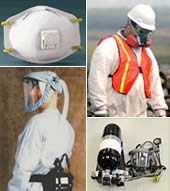RESPIRATORS

Overview
Respirators protect the user in two basic ways. The first is by the removal of contaminants from the air. Respirators of this type include particulate respirators, which filter out airborne particles; and “gas masks” which filter out chemicals and gases. Other respirators protect by supplying clean respirable air from another source. Respirators that fall into this category include airline respirators, which use compressed air from a remote source; and self-contained breathing apparatus (SCBA), which include their own air supply.
Respirators should only be used when engineering control systems are not feasible. Engineering control systems, such as adequate ventilation or scrubbing of contaminants, are the preferred control methods for reducing worker exposures.
NIOSH issues recommendations for respirator use. Industrial type approvals are in accordance to the NIOSH federal respiratory regulations 42 CFR Part 84. Development of respirator standards are in concert with various partners from government and industry.
Spotlight
Respirator Trusted-Source Information Page
This respirator information may be regarded as a trusted source to verify which filtering facepiece respirators are approved by NIOSH, how to get them and how to use them.
Respirator Concern?
Contact NPPTL PPEConcerns@cdc.gov
NIOSH Publications
Preparedness through Daily Practice: The Myths of Respiratory Protection in Healthcare
DHHS (NIOSH) Publication No. 2016-109 (March 2016)
Fact Sheet: Use of Aftermarket Replacement Component Parts for NIOSH-Approved Respirators
DHHS (NIOSH) Publication No. 2016-107 (February 2016)
Worker safety can be compromised by using replacement component parts or accessories that are not NIOSH-approved for the specific respirator.
What’s special about chemical, biological, radiological, and nuclear (CBRN) air-purifying respirators (APR)?
DHHS (NIOSH) Publication No. 2013-157 (September 2013)
The guidance recommended in this fact sheet will help respiratory protection program administrators, managers, and air-purifying respirator (APR) wearers understand the special features of a NIOSH-approved Chemical, Biological, Radiological, and Nuclear (CBRN) APR.
What’s special about chemical, biological, radiological, and nuclear (CBRN) powered air-purifying respirators (PAPR)?
DHHS (NIOSH) Publication No. 2013-156 (September 2013)
This guidance will help respiratory protection program administrators, managers, and powered air-purifying respirator (PAPR) wearers understand the special features of a NIOSH-approved chemical, biological, radiological, and nuclear (CBRN) PAPR.
Fact Sheet: Getting optimal performance from a powered air-purifying respirator (PAPR) depends on the condition of its battery!
DHHS (NIOSH) Publication No. 2013-146 (September 2013) Español
The guidance in this fact sheet will help respiratory protection program administrators, managers, and powered air-purifying respirator (PAPR) wearers understand the importance of a PAPR’s battery in assuring effective respiratory protection.
Respirator Awareness: Your Health May Depend On It
NIOSH Publication No. 2013-138 (June 2013) Español
One of the occupational hazards in the healthcare setting is the airborne transmission of certain infectious diseases. The potential of exposure is not limited to physicians, nurses, and support personnel in direct patient care. It extends to those delivering food, cleaning patient rooms, and performing maintenance. Anyone working in areas with patients infected with airborne-transmissible diseases is potentially at risk.
Fact Sheet: Understanding the Breathing Gas Capacities (ratings) of Escape Respirators for Mineworker Use
DHHS (NIOSH) Publication No. 2013-148 (May 2013)
This information will help workers understand the meaning of breathing gas capacity of a jointly approved National Institute for Occupational Safety and Health (NIOSH) and Mine Safety and Health Administration (MSHA) closed-circuit escape respirator (CCER). Understanding the uses and limitations of the CCER is important in planning for an escape during a mine emergency.
Fact Sheet – NIOSH Approval Labels – Key Information to Protect Yourself
DHHS (NIOSH) Publication No. 2011-179 (May 2011)
NIOSH specifies minimum approval requirements for respiratory protective devices in Title 42 Code of Federal Regulations (CFR) Part 84. NIOSH reviews respirator approval applications, which contain technical specifications, drawings, and other related information. NIOSH also inspects, examines, and tests the respirators to determine that the applicable requirements are met for individual, completely assembled respirators, as described in §84.30(a).
NIOSH Pocket Guide to Chemical Hazards
Exposure limits, respirator recommendations, first aid, more…
The Pocket Guide is a source of general industrial hygiene information on several hundred chemicals/classes found in the work environment. Key data provided for each chemical/substance includes name (including synonyms/trade names), structure/formula, CAS/RTECS Numbers, DOT ID, conversion factors, exposure limits, IDLH, chemical and physical properties, measurement methods, personal protection, respirator recommendations, symptoms, and first aid.
Respirator Resources
Certified Equipment List
The Certified Equipment List (CEL) is a database of all NIOSH-approved respirators.
NIOSH-Approved Particulate Filtering Facepieces Respirators
This site provides a listing of NIOSH-approved particulate filtering facepiece respirators.
NIOSH Videos
A Particle is a Particle (July 2016)
Research Testing of Total Inward Leakage of Negative Pressure Respirators (March 2016)
Respirator Certification – As Vital as the Air We Breathe (January 2014)
Respiratory Protection for Healthcare Workers Training Video (January 2011)
A presentation about the use of respirators in healthcare settings.
The Difference Between Respirators and Surgical Masks Video (December 2009)
A presentation about the difference between respirators and surgical masks.
Donning (Putting on) and Doffing (Taking off) and User Seal Checks Video (December 2009)
A presentation about donning (putting on) and doffing (taking off) and user seal checks.
OSHA Videos
Respirator Safety (Training Video section)
OSHA Respiratory Protection Videos (January 2012)
- Respiratory Protection in General Industry
- Respiratory Protection in Construction
- Respirator Types
- Respirator Fit Testing
- Maintenance and Care of Respirators
- Medical Evaluations for Workers who use Respirators
- Respiratory Protection Training Requirements
- Voluntary Use of Respirators
- Counterfeit and Altered Respirators: The Importance of NIOSH Certification
User Notices
Other Resources
- Page last reviewed: July 27, 2017
- Page last updated: August 26, 2016
- Content source:
- National Institute for Occupational Safety and Health National Personal Protective Technology Laboratory


 ShareCompartir
ShareCompartir